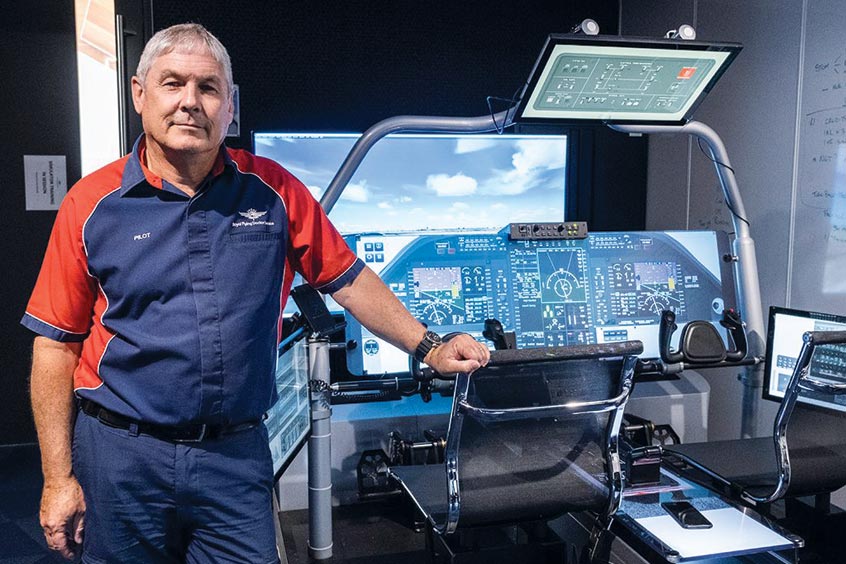Why visit ACE ’25?




The Royal Flying Doctor Service's (RFDS) Adelaide base has taken delivery of a portable flight simulator from FlightSafety International. The MissionFit simulator is specially configured to simulate the RFDS Pilatus PC-12, of which there are 19 in the Australian aeromedical provider's fleet in South Australia and Northern Territory. The simulator enables pilots to navigate normal and abnormal scenarios and adverse weather conditions, while completing all of the necessary checks and procedures in a real flight.
Central operations head of training and checking Matthew Cosier says: “When commercial pilots join the Flying Doctor, they need to have a minimum of 2,500 flying hours with experience flying in rural and remote Australia, but generally they have never flown a PC-12 aircraft. Firstly, we have to put them through ground school and then weeks of rigorous training with a pilot instructor before they're signed off to fly on their own.
“The MissionFit will allow us to train pilots to a new level of standard, in particular handling the system failures that we can't simulate when we're flying in the real aircraft. With emergency retrievals required day and night, pilots must be adept at handling all scenarios and weather conditions.”
Central operations line pilot Heather Ford flies around 50 hours each month, airlifting patients across central Australia. She says: “Having the MissionFit makes the simulation as real as it possibly can be without any risk to the crew or the aircraft; we'll be put through certain scenarios so that we can recognise and deal with them before they become an emergency. Every decision we make is based on the experience we have. The more situations you expose pilots to, the better the pilot is going to be.”
Each year, the Flying Doctor airlifts more than 53,000 patients in South Australia and Northern Territory. Having this interactive device relieves more aircraft from training duties, increasing the RFDS's capacity to provide vital 24/7 aeromedical services to all corners of central Australia. Pilots can train at any time without worrying about aircraft availability, air traffic congestion or poor weather conditions hindering their mandatory training.
“As RFDS pilots we have to successfully pass four checks a year. These checks range between two and three hours each, around half of which can be conducted in the MissionFit simulator,” adds Ford. “By taking all the possible mandatory training we can out of a real aircraft and into the simulator, it means more of the RFDS fleet is available to continue to save lives.”
There are also the added economic and environmental benefits of the simulator; financial savings made on fuel due to reduced actual flight time, as well as lower emissions and carbon footprint.
“But the people who are going to benefit the most are patients of the RFDS,” says Cosier. “Our pilots will be able to deliver a new level of safety as we continue to support healthier and happier Australians, no matter where they live, work or play.”
MissionFit is a CASA-approved flight simulation training device and in the future may be able to simulate the RFDS Pilatus PC-24 Medi-Jet.
The Queensland section of RFDS has received a $3 million commitment from QCoal Foundation for a new world-class aviation training facility in Bundaberg. The new facility will be constructed next to the existing base and will house the only full-motion Beechcraft King Air B350/360 Fusion flight training simulator outside of the US.
Queensland section chief executive officer Meredith Staib says: “The B360 aircraft will be introduced into our fleet this year, and the new facility will support the ongoing training of our highly-skilled pilots and pilots from right across Australia and Asia. Today’s announcement is an extension of our long-standing partnership with QCoal Foundation and further evidence of its commitment to supporting health outcomes for regional Queensland and beyond.
“With $15 million in support from the Australian Government already committed to the facility, this additional funding will help secure the future of this essential project for Queensland and Australia.”
QCoal chair Christopher Wallin adds: “Like our work with the RFDS Dental Service, we are extremely proud to again be partnering with the RFDS to deliver a 'first of its kind' initiative which will deliver enormous benefit to regional Queensland. This is about much more than frontline health service delivery; this initiative will support economic diversification in the Bundaberg region and will provide a sustainable commercial opportunity for the RFDS.”